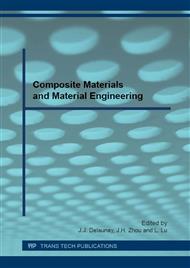p.125
p.135
p.140
p.144
p.148
p.152
p.156
p.160
p.166
Compressive Behavior of Concrete Confined by Hemp Fiber Composite Jackets
Abstract:
This paper presents an experimental study on the strengthening of small scaled concrete columns externally confined with hemp fiber composite jackets. The major benefit of using hemp fiber is that their low price, high toughness, and hemp is natural fiber product which that can be found locally. In this study, two different types of columns i.e. circular and square were casted and tested under axial compression. The hemp fiber composite jacket of different thicknesses i.e. 2 and 4 layers were applied using epoxy resin. The test result show that hemp fiber composite jackets are very effective to enhance compressive strength and deformability of the confined concrete. There is found increase in ultimate load carrying capacity with an increase in the jacket thickness. The efficiency of hemp fiber composite jackets is found higher for circular columns then square columns.
Info:
Periodical:
Pages:
148-151
Citation:
Online since:
July 2016
Authors:
Keywords:
Price:
Сopyright:
© 2016 Trans Tech Publications Ltd. All Rights Reserved
Share:
Citation:


